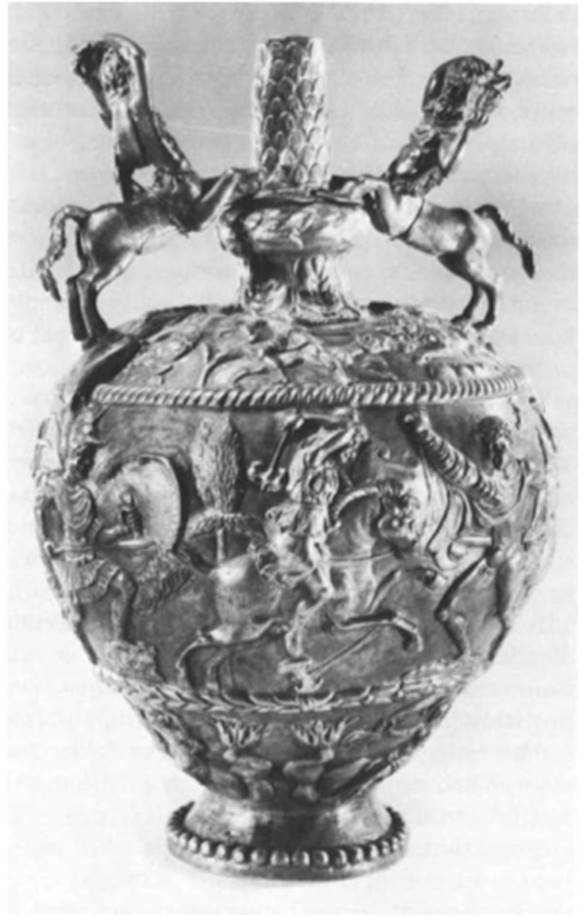The Concesti amphora. Black Sea region, about 400. Silver with gilding
Three registers of figural ornament decorate the body of the large vessel, which is further elaborated with a beaded foot and three zones of floral molding at the neck. The figural registers are divided from one another by torque and wreath borders. Two handles in the form of centaurs formerly arched from the shoulder of the amphora to the convex molding on the neck. The handles were thought to be later additions and were subsequently removed, although they can be seen in this photograph. All decoration is worked in repousse with details of the figures accented with gilding. Engraved line, stippling, and punchwork indicate fine details and surface textures on the reliefs; incised line is occasionally used to indicate limbs of figures.

The three zones of figural decoration refer to the hunt, to the battle between the Greeks and the Amazons, and to the sea. The hunt scene on the shoulder shows the capture of a doe and a stag in a net enclosure and the taking of a wild boar with a pack of dogs. Each hunt is attended and framed by the figures of two hunters on foot, who wear short tunics and carry staffs; one attendant in the stag hunt wears a hooded cloak. The sea creatures of the bottom band are three Nereids mounted on sea monsters, an abbre viated sea thiasos commonly peopled by Tritons and various marine deities. The sea monsters are hybrids: a hippocamp, a sea lion, and one creature that is half fish and half long-horned goat.
The battle of the Greeks and the Amazons in the central register consists of eight figures grouped in three battle scenes. The Amazons wear caps, boots, and short tunics girdled below the breasts. Three charge to the right on horseback wielding double-headed axes and the distinctly shaped peltae. The fourth Amazon kneels in defeat at the hands of a Greek warrior, who, like one other, is in full military dress, carrying a spear. Another Greek, armed with a sword, goes into battle nude except for boots and a mantle; and the fourth Greek, clad in helmet and boots, brandishes a sword and shield.
As a group, the Greek warriors are larger than the Amazons, who, although mounted on charging horses, rise only to the height of their adversaries. The disproportionately large left arm of the kneeling Amazon is paralleled in the varying proportional types of the male fighters. The short, stocky figural types of the hunters in the band above and the relatively classical figures of the Nereids in the band below find little reflection in the main battle register. Such disparities may reflect the relatively faithful copying of three different sources.
An attempt is made to establish an axial alignment of the three zones. The pair of the fallen Amazon and conquering Greek accords with the center of the stag hunt above and conforms to the break between two confronted Nereids below. The battle scene so emphasized may be that in which Penthesilea, queen of the Amazon tribe, meets her death at the hands of Achilles. Bibliography: Matzulevich, 1929, pp. 132, 134, pis. 36—43; Buschor, 1943, pp. 7, 9, 13, 24, 26; Edinburgh, 1958, nos. 40a, b; Rice, 1959, pp. 287-288, pis. 6-7.
Date added: 2025-08-31; views: 79;
